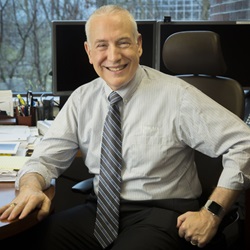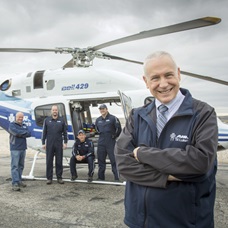Dr. Pate’s Prescription for Change
St. Luke’s Hospice helps patients optimize every minute

St. Luke’s Hospice makes a significant difference in the care of terminally ill patients. From alleviating pain and anxiety to addressing the spiritual needs of patients to helping improve the quality of life, hospice is a godsend, and the people who work at St. Luke’s Hospice are very special people called to this line of work.
Here with a report about the work of St. Luke’s Hospice is St. Luke’s Content and Communications Manager Holly Anderson.
- David C. Pate, M.D., J.D.

Oct. 11 was a blur for Sandra Lewis of Boise. She just remembers hearing that she only had about a month left to live.
“I was told that every cell in my body is full of cancer,” she said.
The next day, Lewis put her worries aside to celebrate her husband’s 75th birthday. Lewis, who has battled two rounds of bladder cancer in the past few years, shares a large blended family and an enduring faith in Christianity with her husband of 24 years, Vernon Lewis. It was important to her that Vernon have his special day before they revealed her sobering news to their wider circle of family and friends.
Lewis, 72, had also made another key decision. She wants to live her remaining days in her West Boise home with her beloved husband and dachshund, Rudy (aka Red Rudolph). She was referred to St. Luke’s Hospice and on Oct. 13, the team began working with Lewis, providing the guidance, resources and services she needs at this stage of her illness to keep her out of the hospital or an assisted living facility.
And while it’s been “one rollercoaster ride after another,” Lewis praises the support she’s received in hospice and the difference it’s made in helping her cope. The hospice team makes sure she gets her medication delivered to her door, and there are regular nursing visits as well as services like massage to help manage her pain and much more.
Lewis is one of hundreds of patients who receive services from St. Luke’s Hospice each year. The program serves 13 counties, with central offices in Boise, McCall and Twin Falls.
With St. Luke’s Hospice, support is provided seven days a week, 24 hours a day, including holidays, which means that patients and their families always have vital access.
“Our team really works in a sacred territory,” said Kendra Tietz, St. Luke’s Hospice clinical manager. “We are invited to companion and walk alongside patients and their families at such a vulnerable and intense time.”
Believed to be one of the first hospice programs in the state, St. Luke’s Hospice got its start in the 1980s when it was then a part of St. Luke’s Mountain States Tumor Institute. Part of the St. Luke’s umbrella, the program is a not-for-profit entity, unlike many other hospice programs in Idaho.
Also unlike many of the other hospice programs in the state, about 70 percent of the patients in St. Luke’s Hospice are cancer patients. The team also works with patients who have dementia, respiratory illnesses, ALS and more. Many St. Luke’s Hospice patients are in their 30s and 40s, with costly, complicated cancer diagnoses and a wide range of issues, from employment and insurance to child-care concerns.
Hospice care “focuses on caring, not curing,” and in most cases, care is provided within the patient’s home. Even so, “patients often aren’t referred to us soon enough,” Tietz said.
“Patients are living a lot longer, and we can help educate them to better navigate their journey,” said Kennette McWilliams, St. Luke’s Hospice operations manager.
Lewis understands that need for information. She spent her first days after receiving the news nervously waiting. She wasn’t herself. She felt frozen.

“I wasn’t doing anything,” Lewis said. “I wasn’t me. Me is busy. Me is doing things.”
She credits an idea from St. Luke’s Hospice Chaplain Craig Kennedy for getting her back on track.
Kennedy, who visits with Lewis at least once a week, discovered her passion for needlework and other fabric crafts, and suggested that she spend some of her time making blankets for other hospice patients, many of whom appreciate the added warmth during their illnesses. The hospice staff has worked to help Lewis find fabric or fabric money so that she and her husband won’t have to stretch their already tight income.
“Craig felt I would do better if I was busy,” Lewis said.
Hospice chaplains do more than pray, coordinate the blessing of the sick or handle other traditional religious practices, McWilliams said. They work with each patient to find out what “fuels their spirit and their soul and connect it back” to that person’s everyday life.
Lewis, who over the years had worked as a seamstress among her many professions and was also a longtime community volunteer, was elated to find a sense of purpose again.
“I love to do volunteering,” Lewis said. “I love to give my stuff away.”
To be eligible for hospice, patients must have their own 24-hour caregiver or contact. Vernon Lewis is his wife’s main support, and he’s noticed changes in her since they’ve started the hospice program.
“At first, she needed a walker. Then, she went to a cane,” he said. “Now, she doesn’t need anything. And the massage therapist. She’s the best. She makes Sandy’s shoulders and legs feel better.”
St. Luke’s Hospice patients also can access nutritional support, help from home-health aides, social work services and much more, including pet services through Pet Peace of Mind, a program the hospice participates in through a grant that allows the hospice to help with dog treats, toys and more. The program also can help with finding new homes for patients’ pets.
“If they know their pet is going to be OK, then they are OK,” McWilliams said.
Tietz said hospice aims to be “proactive, not reactive. We want to anticipate their needs before the needs occur.”
“Patients live longer with hospice care than they do without,” McWilliams said.
That’s vital for patients like Lewis.
“I feel the Lord has given me back some of my life,” she said.

And on the day that hospice care comes to an end, the team is there for the patient’s family. Bereavement services, counseling and grief-support groups are a critical part of the St. Luke’s Hospice process. That provides some comfort for patients like Lewis.
“I used to do CPR work, home care,” Lewis said. “I saw people pass from this world to the next. When God ushers me into heaven, I know he is going to give me peace. I hope he can bring some peace to my family and friends, too.”
Lewis has more than beaten the odds she was given on that fall day. She and Vernon even took a vacation in late November to Seaside, Ore. A St. Luke’s Hospice social worker helped arrange the trip through Wish Granters, a local nonprofit that fulfills final wishes for adult patients.
“I was born in Oregon,” she said. “I wanted to be able to walk along the beach one more time.”
The family just celebrated another merry Christmas, and Lewis is in constant contact with her many longtime friends around the country, talking, texting and sharing laughs, just like they have for decades.
“I really believe that God is taking care of me,” Lewis said. “He brought me the people in my life to guide me to the place that I need to be.”
About The Author

Holly M. Anderson works in the Communications and Marketing department at St. Luke's.


